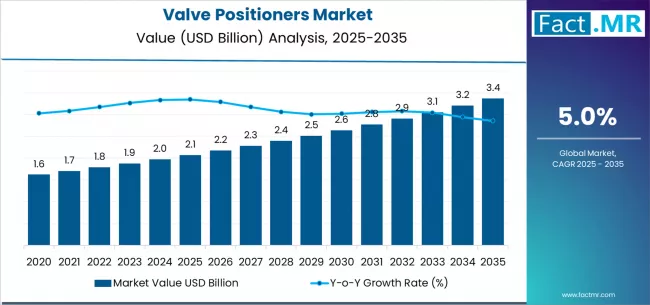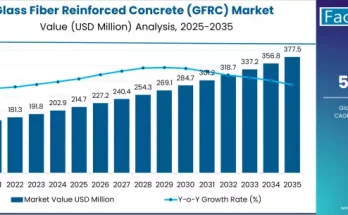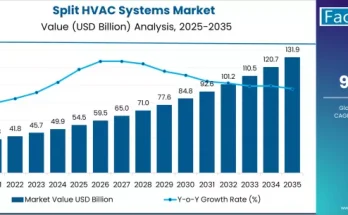The valve positioners market stands at the threshold of a decade-long expansion trajectory that promises to reshape industrial automation and process control technology. According to a new analysis by Fact.MR, the market is projected to grow from USD 2.07 billion in 2025 to USD 3.37 billion by 2035, advancing at a CAGR of 5.0% and achieving an absolute gain of USD 1.3 billion over the forecast period.
The growth outlook is driven by rising industrial automation, precision flow requirements across critical applications, and digital transformation initiatives sweeping across oil & gas, power, chemical, and water treatment sectors. Smart valve positioners—equipped with diagnostics, feedback systems, and digital communication protocols—are rapidly replacing conventional devices.
Strategic Market Drivers
Industrial Automation Accelerates Global Demand
Industries worldwide are shifting toward automated control systems to enhance accuracy, reduce human intervention, and improve operational efficiency. Valve positioners are essential components in modulating control valves, ensuring accurate valve travel, faster response time, and steady-state performance.
Growing investments in smart factories and Industry 4.0 are fueling adoption of digital and intelligent valve positioners.
Precision Flow Control Gains Priority
Stringent requirements in petroleum refining, chemical processing, pharmaceuticals, and power generation demand optimal control accuracy. Modern valve positioners with self-calibration, diagnostics, and remote monitoring capabilities are enabling higher process reliability, minimized downtime, and reduced maintenance costs.
Browse Full Report: https://www.factmr.com/report/valve-positioners-market
Digital Transformation & Smart Technologies Drive Innovation
Smart Positioners Enhance Predictive Maintenance Capabilities
Manufacturers are integrating advanced sensors, IoT connectivity, and communication standards such as HART, Foundation Fieldbus, and Profibus. These innovations support predictive maintenance, early fault detection, and real-time process optimization—making them indispensable for high-value industrial operations.
Adoption of Energy-Efficient & Sustainability-Focused Systems
Global industries are prioritizing energy-efficient systems to cut emissions and operational costs. Advanced valve positioners reduce air consumption, optimize valve travel, and improve process stability—aligning with green manufacturing goals and environmental compliance regulations.
Regional Growth Highlights
North America: Digitalization & Heavy Industrial Base Fuel Growth
North America leads the market supported by a robust oil & gas sector, strong adoption of digital control instruments, and continuous investment in power plant modernization. The U.S. remains a primary contributor, with rising demand for smart valve automation solutions.
Europe: Sustainability & Process Optimization Shape Adoption
Europe’s process industries—chemicals, pharmaceuticals, and power—are embracing precision valve control technologies. High emphasis on energy savings, safety compliance, and plant reliability accelerates demand for intelligent and low-maintenance valve positioners.
East Asia: Manufacturing Expansion & Smart Factory Deployment
China, Japan, and South Korea are at the forefront of automation upgrades, fueling the need for digital and electro-pneumatic valve positioners. Rapid industrialization and government-led smart manufacturing initiatives are strengthening regional momentum.
Emerging Markets: High-Growth Industrialization Corridors
India, Southeast Asia, Middle East, and Latin America show substantial growth potential due to rising industrial investments, expanding refinery capacities, and modernizing water and wastewater infrastructure.
Market Segmentation Insights
By Type
- Electro-Pneumatic Valve Positioners – Dominant due to precise control and diagnostic capabilities.
- Pneumatic Valve Positioners – Strong demand in rugged, hazardous, and remote industrial environments.
- Digital/Smart Valve Positioners – Fastest-growing category driven by Industry 4.0 and remote monitoring needs.
By Actuation
- Linear Valves
- Rotary Valves
By Application
- Oil & Gas
- Chemical Processing
- Power Generation
- Water & Wastewater Treatment
- Food & Beverage Industries
- Pharmaceuticals
- Pulp & Paper
Key Challenges Impacting Market Growth
- High Initial Investment – Advanced smart positioners require significant upfront costs.
- Complex Installation & Calibration – Skilled workforce shortages can delay adoption.
- Harsh Operational Environments – Extreme temperatures and corrosive conditions impact product longevity.
- Competition from Low-Cost Alternatives – Local manufacturers in Asia pose challenges to global brands.
Competitive Landscape
The valve positioners market is moderately consolidated with companies focusing on product accuracy, fault diagnostics, and seamless integration with advanced control systems.
Key Companies Profiled:
• Emerson Electric Co.
• ABB Ltd.
• Siemens AG
• Schneider Electric
• Azbil Corporation
• Baker Hughes
• Flowserve Corporation
• Metso Corporation
• Rotork Plc
• SAMSON Controls Inc.
Manufacturers are prioritizing digital valve controllers, low-maintenance designs, and enhanced communication protocols to cater to the efficiency-driven industrial ecosystem.
Recent Developments
- 2024: Launch of next-generation electro-pneumatic smart positioners with enhanced diagnostics, Bluetooth connectivity, and reduced air consumption.
- 2023: Major chemical plants in Europe and the U.S. initiated large-scale retrofitting projects adopting intelligent valve automation systems.
- 2022: Increased deployment of digital valve controllers in water treatment facilities to improve efficiency and regulatory compliance.
Future Outlook: The Era of Smart Valve Control Systems
The next decade will mark rapid upgrades in process automation and control infrastructure. With widespread adoption of digital technologies, remote monitoring, and predictive maintenance, the valve positioners market is set for sustained and robust growth.
Companies that invest in data-driven control systems, IIoT integration, energy-efficient devices, and sustainability-focused innovations will lead the evolution of industrial flow management. As industries move toward fully automated and intelligent operations, valve positioners will remain critical enablers of precision, reliability, and operational excellence.



